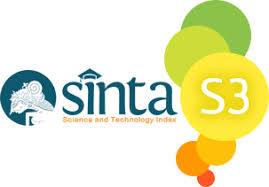Kelas Sosial Dan Perempuan Generasi Z di Surabaya Dalam Membuat Keputusan Setelah Lulus Sekolah Menengah Atas
 Abstract views: 2056
,
Abstract views: 2056
,
 PDF downloads: 3088
PDF downloads: 3088
Abstract
This paper describes how the social class determines the women generation Z in making decision after graduating from high school. From the results, it was obtained that women generation Z in Surabaya from upper middle and middle lower classes both have plans to continue their education to the university level after high school graduation. They both found that early-age marriege is not a goal when they have graduated from high school, because there are many things that should be prepared when they will reach the level of marriage. According to them the experience after graduating from high school such as working or pursuing their education at the university level is important for their lives in the future. Thus, it can be concluded that social class is so influential for the women generation Z in making decisions after graduating from high school. In addition, in the next six years the number of marriages of women generation Z will be decreased from the marriage of women generation Y. In the working world in the next six years will be fulfilled by many women generation Z Surabaya.
Keywords: Social Class, Women, z generation
References
Brown, D.F. (2009). Social class and Status. In Mey, Jacob. Concise Encyclopedia of Pragmatics. Elsevier. ISBN 978-0-08-096297-9.
Budirahayu, T. (1999). Aspirasi Siswa SMU dan Orangtuanya pada Pendidikan dan Pekerjaan Kaitannnya dengan Rencana Siswa untuk Melanjutkan Pendidikan ke Perguruan Tinggi (Pandangan Fungsionalisme pada Aspirasi Pendidikan dan Pekerjaan dari Para Siswa SMU beserta Orangtuanya). Vol.7, No.3,9-22.
Dewey, J. (1944). Democracy and Education. The Free Press. ISBN 0-684-83631-9.
Dony, P. E. (2015). Rezim Pertumbuhan Kota Surabaya Studi tentang Pembangunan dan Revitalisasi Hotel di Surabaya. Jurnal Politik Muda, Vol. 4 No. 1, Januari-Maret 2015, 71-78.
Dwi, S. Rachmad, K. (2008). 20 Tokoh Sosiologi Modern. Yogyakarta : Ar-Ruzz Media.
Eric, A. (2005). Economic outcomes and school quality. International Institute for Educational Planning. ISBN 978-92-803-1279-9.
Genat, A, Wood, R, Sojo, V (2012). Gender equality project: Evaluation bias and backlash, pp. 1–52; Rudman, LA, & Phelan, JE (2008), Backlash effects for disconfirming gender stereotypes in organizations, Research in Organizational Behavior, vol.28, pp. 61–79.
http://www.businessdictionary.com/definition/social-class.html
Huang, L. (2010). Cross Communication In Business Negotiation. Vol.2, No.2,196-199.
Kerbo, H. (1996). Social Stratification and Inequality. New York: The McGraw-Hill Companies Inc. ISBN 0-07-034258-X
Maclean, M; Harvey, C; Kling, G. (2014). Pathways to Power: Class, Hyper-Agency and the French Corporate Elite. Organization Studies. ISSN 0170-8406. doi:10.1177/0170840613509919
Neuman, W. L. (2016). Social Research Methods: Qualitative and Quantitative Approaches, 7th edition. Pearson. Boston.
Soekanto, S. (2007). Sosiologi Suatu Pengantar. Jakarta: Rajawali Press.
Sumarwan, U. (2004). Perilaku Konsumen : Teori dan penerapannya dalam pemasaran. Bogor: Ghalia Indonesia.
Susilo, D., & Kodir, A. (2016). Politik Tubuh Perempuan: Bumi, Kuasa, dan Perlawanan. Jurnal Politik, 1(2), 317-330.
Taspcott, Don (2008). Grown Up Digital: How the Net Generation is Changing Your World. McGraw-Hill.
Wibowo, D. E. (2011). Peran Ganda Perempuan dan Kesetaraan Gender. Muwazah Vol.3, No. 1, 356-364.
Wilson, T. (2002). The Paradox of Social Class and Sports Involvement. International Review for the Sociology of Sport.
Copyright (c) 2018 Jurnal Komunikasi Profesional

This work is licensed under a Creative Commons Attribution-ShareAlike 4.0 International License.

Jurnal Komunikasi Profesional is licensed under a Creative Commons Attribution-ShareAlike 4.0 International License.
1. Proposed Policy for Journals That Offer Open Access
Authors who publish with this journal agree to the following terms:
- Authors retain copyright and grant the journal right of first publication with the work simultaneously licensed under a Creative Commons Attribution License that allows others to share the work with an acknowledgment of the work's authorship and initial publication in this journal.
- Authors are able to enter into separate, additional contractual arrangements for the non-exclusive distribution of the journal's published version of the work (e.g., post it to an institutional repository or publish it in a book), with an acknowledgement of its initial publication in this journal.
- Authors are permitted and encouraged to post their work online (e.g., in institutional repositories or on their website) prior to and during the submission process, as it can lead to productive exchanges, as well as earlier and greater citation of published work (See The Effect of Open Access).
2. Proposed Policy for Journals That Offer Delayed Open Access
Authors who publish with this journal agree to the following terms:
- Authors retain copyright and grant the journal right of first publication, with the work [SPECIFY PERIOD OF TIME] after publication simultaneously licensed under a Creative Commons Attribution License that allows others to share the work with an acknowledgement of the work's authorship and initial publication in this journal.
- Authors are able to enter into separate, additional contractual arrangements for the non-exclusive distribution of the journal's published version of the work (e.g., post it to an institutional repository or publish it in a book), with an acknowledgement of its initial publication in this journal.
- Authors are permitted and encouraged to post their work online (e.g., in institutional repositories or on their website) prior to and during the submission process, as it can lead to productive exchanges, as well as earlier and greater citation of published work (See The Effect of Open Access).



